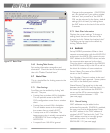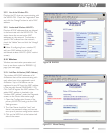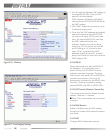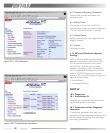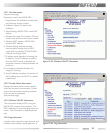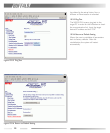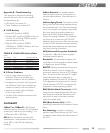
28
ROM (Read Only Memory): Permanent
memory.
Router: A device that can connect individual
LANs and remote sites to a server.
Roaming: The ability to use a wireless device
and be able to move from one access point to
another without losing the connection.
Script: A macro or batch file that contains
instructions that the computer executes to
perform a task.
Server: Any computer that makes access to
files or peripheral devices available to users of
the network.
SMTP (Simple Mail Transfer Protocol):
The protocol used to define and deliver
electronic mail (e-mail) from one server to
another.
SNMP (Simple Network Management
Protocol): An application layer protocol that
outlines the formal structure for communica-
tion among network devices.
Static IP Address: Also known as a global IP.
A permanent IP address that is assigned to a
node in a TCP/IP network.
STP (Shielded Twisted Pair): See Twisted
Pair.
Subnet Mask: An eight byte address divided
into 4 parts grouped by periods.
TCP/IP (Transmission Control Proto-
col/Internet Protocol): The protocol used
by computers when they communicate across
the Internet or Intranets.
TFTP (Trivial File Transfer Protocol):
Simple form of FTP (File Transfer Protocol).
Uses UDP (User Datagram Protocol) and
provides no security features.
TKIP (Temporal Key Integrity Proto-
col): An encryption method replacing WEP.
TKIP uses random IV and frequent key
exchanges.
Topology: The shape of a LAN (Local Area
Network) or other communications system.
Twisted Pair: Cable that comprises 2 or
more pairs of insulated wires twisted together
UDP (User Datagram Protocol): A
communication method (protocol) that offers
a limited amount of service when messages
are exchanged between computers in a
network. UDP is used alternatively to TCP/IP.
Uplink: Links to the next level up in the
herarchy of a network.
UTP (Unshielded Twisted Pair) cable:
A standard UTP cable has straight-through
wiring. See Twisted Pair.
WAN (Wide Area Network): A network-
ing system that covers a wide geographical
area.
WDS (Wireless Distribution System): A
method for an AP to communicate with
another AP. This method is powerful for point-
to-point or point-to-multipoint infrastructure.
WEP (Wired Equivalent Privacy): An
encryption method based on 64 or 128bit
algorithm.
Web Browser: A software program that
allows the user to view Internet pages.
Wi-Fi (Wireless Fidelity): An organization
that tests and assures interoperability among
WLAN devices.
Wire Speed: The maximum speed that a
given packet can be transferred using Ethernet
and Fast Ethernet standard specifications.
WLAN (Wireless LAN): A LAN topology
using wireless devices.
VPN (Virtual Private Network): A
security method to connect remote LAN
users to their corporate LAN system.



